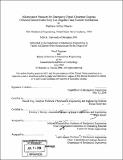Maintenance practices for emergency diesel generator engines onboard United States Navy Los Angeles class nuclear submarines
Author(s)
Hawks, Matthew Arthur
DownloadFull printable version (6.498Mb)
Other Contributors
Massachusetts Institute of Technology. Dept. of Mechanical Engineering.
Advisor
Daniel Frey.
Terms of use
Metadata
Show full item recordAbstract
The United States Navy has recognized the rising age of its nuclear reactors. With this increasing age comes increasing importance of backup generators. In addition to the need for decay heat removal common to all (naval and commercial) nuclear reactors, naval vessels with nuclear reactors also require a backup means of propulsion. All underway Navy nuclear reactors are operated with diesel generators as a backup power system, able to provide emergency electric power for reactor decay heat removal as well as enough electric power to supply an emergency propulsion mechanism. While all commercial nuclear reactors are required to incorporate multiple backup generators, naval submarine nuclear plants feature a single backup generator. The increasing age of naval nuclear reactors, coupled with the dual requirements of a submarine's solitary backup generator, makes the study of submarine backup generators vital. This thesis examines more than 7,000 maintenance records dated 1989 to 2005 for emergency diesel generator engines onboard Los Angeles class nuclear submarines. This class of submarines, which features the Fairbanks Morse 8-cylinder air-started opposed-piston diesel engine, is expected to continue to operate until at least 2020. (cont.) An analysis of corrective and routine maintenance tasks was conducted. Analysis included the diesel engine as well as its subsystems of diesel lube oil, diesel freshwater, diesel seawater, diesel air start, and diesel fuel oil. The analysis centered on maintenance task times and costs. Time factors analyzed included the time between maintenance actions, the time awaiting parts, the time to conduct the maintenance, and the impacts on operational availability. Cost factors analyzed included the material costs and the manpower costs (both sailors and off-hull workers). As patterns were recognized, high impact items were highlighted and recommendations to reduce risk to operational availability were given.
Description
Thesis (Nav. E. and S.M.)--Massachusetts Institute of Technology, Dept. of Mechanical Engineering, 2006. Includes bibliographical references (leaf 41).
Date issued
2006Department
Massachusetts Institute of Technology. Department of Mechanical EngineeringPublisher
Massachusetts Institute of Technology
Keywords
Mechanical Engineering.